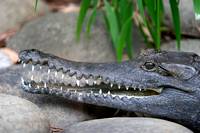Australian Crocodiles
Australian crocodiles are famous all over the world thanks to Crocodile Dundee.
And if you thought that was just a movie, think again...
Australian saltwater crocodiles are responsible for several fatal accidents in recent years.
In all cases the accident was the result of wrong behaviour by the victim.
Crocodile attacks can easily be avoided.


On these pages you can find out more about Australian crocodiles, both the harmless freshwater and the dangerous saltwater crocodile.
Australian Crocodiles - The Freshwater Crocodile
The Australian Freshwater or Johnston Crocodile (Crocodylus johnstoni) occurs only across northern Australia. Its main habitat are lakes, swamps, billabongs and the upstream areas of small rivers. They can tolerate salinity. The reason they aren't found in the more tidal parts of rivers near the coast is that the bigger and aggressive Australian saltwater crocodiles don't tolerate "Freshies".
(That can be good news. A body of water that contains lots of freshwater crocodiles is unlikely to be inhabited by a saltwater crocodile...)

Freshwater crocodiles are small. Females grow to about 2m, males can reach up to 3m, but it takes them 30 years to reach that size. Most of them are a lot smaller.
Their maximum weight is about 90kg (compared to over a ton for a saltwater crocodile...)
The head is very distinctive, nothing like the heavy, solid, strong head of a saltwater crocodile. A freshwater crocodile has a small slender head with an unusually long snout for a crocodile.
Freshies are mainly fish eaters, but also take a variety of other small animals, whatever they can get hold of...
The breeding season is the dry season, from July to September. The females dig holes in sandy river banks and lay about a dozen eggs. They don't guard the nest like saltwater crocodiles do, but they do return when the young crocodiles hatch. The also carry their young to the water and keep an eye on them for a while, but nowhere near as long as a saltwater crocodile would.
If the female crocodile is disturbed at all during that period she is likely to abandon her offspring, so please take that into consideration when you see crocodiles during that time of the year. Even without our intervention only 1% of the hatchlings will reach maturity. They are very susceptible to predation and cannibalism is common when food is scarce. There a years where none of the hatchlings survive...
Freshies aren't aggressive, rather shy, but if disturbed during the breeding season or if they feel threatened they may attack. Their teeth are razor sharp and they can inflict serious wounds.
Freshwater crocodiles are a protected species. Their number is estimated to be at least 100,000. Some farming programs exist for commercial purposes, although their hide is nowhere near as valuable as saltwater crocodile skin. Their populations across Australia are very healthy. The biggest danger these Australian crocodiles will be facing in the future is, as for many other species in this world, crocodile habitat destruction...
Read about saltwater crocodiles and crocodile attacks in Australia.
All Australian Animals | Australian Outback Animals
Return from Australian Crocodiles to Outback Australia Travel Guide home page





